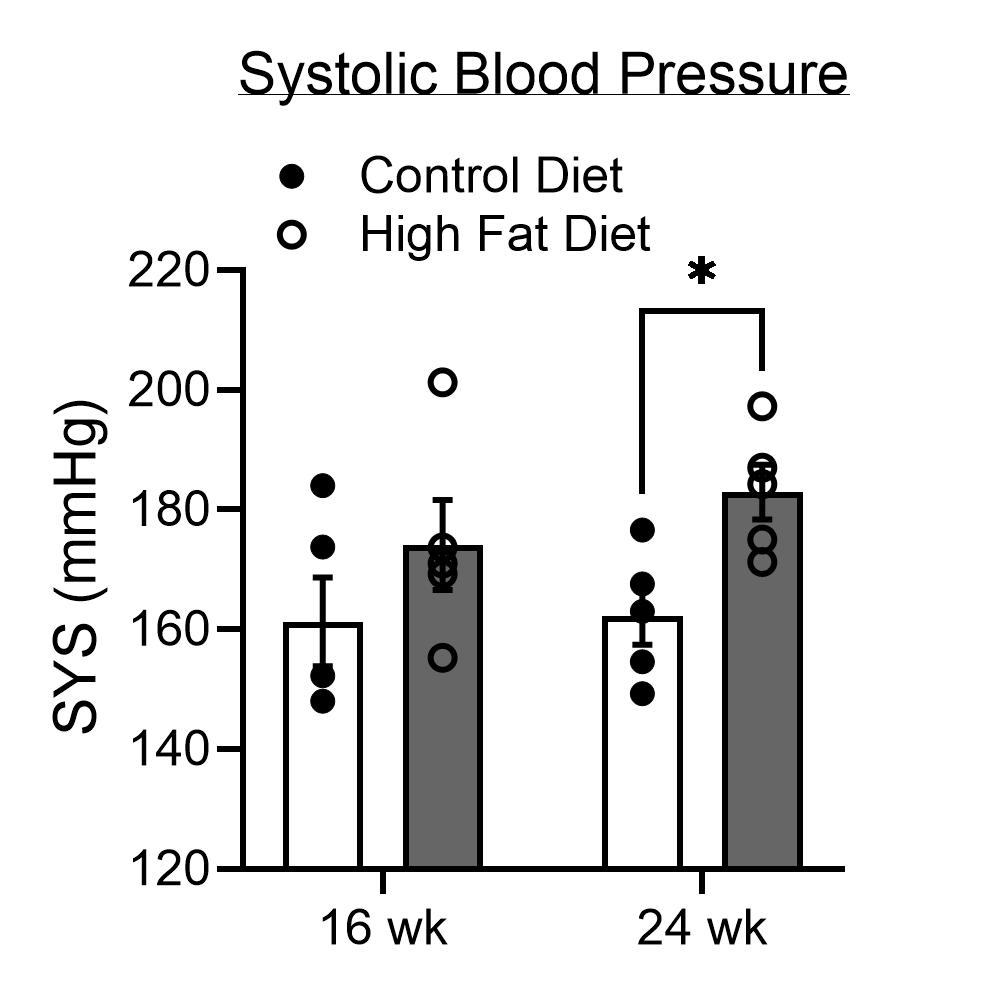Final ID: P-451
Effects of Perivascular Adipose Tissue on Arterial Stiffness in an Adiposity-Driven Hypertension Model: A Longitudinal Study
Abstract Body: Dillon McClintock, Department of Mechanical Engineering, Michigan State University, East Lansing, MI
Sydney Bush, Department of Mechanical Engineering, Michigan State University, East Lansing, MI
Lisa Sather, Department of Pharmacology and Toxicology, Michigan State University, East Lansing, MI
Nathan Tykocki, Department of Pharmacology and Toxicology, Michigan State University, East Lansing, MI
Adam Lauver, Department of Pharmacology and Toxicology, Michigan State University, East Lansing, MI
Stephanie W Watts, Department of Pharmacology and Toxicology, Michigan State University, East Lansing, MI
Sara Roccabianca, Department of Mechanical Engineering, Michigan State University, East Lansing, MI
Perivascular adipose tissue (PVAT) is crucial for maintaining arterial function under healthy conditions. This research aims to test the hypothesis that the effect of PVAT on arterial stiffness is lessened as hypertension progresses in an animal model of adiposity-driven hypertension. We examined thoracic aorta samples from male Dahl Salt-Sensitive rats subjected to control (10% fat-CD) and high-fat (60% fat-HFD) diets for 16 and 24 weeks. Systolic blood pressure was significantly higher in HFD rats only at 24 weeks as compared to CD. Uniaxial mechanical tests were then conducted on aorta samples with and without PVAT. Arterial wall stiffness at 20% stretch (matching in vivo measures) was increased but not significantly higher in animals fed a HFD compared to those on a CD at 16 weeks but not 24 weeks. Surprisingly, the calculated stiffness of -PVAT samples significantly decreased by 24 weeks in both groups. Stiffness was reduced at both time points in +PVAT samples compared to -PVAT, but the beneficial effect of PVAT is diminished at 24 weeks. Because lower stretches may be important as hypertension progresses. We also measured stiffness at stretches <10%. Here, the addition of PVAT lost all beneficial effects on stiffness at 24 weeks. These results suggest that while PVAT has a beneficial effect on arterial stiffness in adiposity-driven hypertension, its effectiveness decreases with aging.
Sydney Bush, Department of Mechanical Engineering, Michigan State University, East Lansing, MI
Lisa Sather, Department of Pharmacology and Toxicology, Michigan State University, East Lansing, MI
Nathan Tykocki, Department of Pharmacology and Toxicology, Michigan State University, East Lansing, MI
Adam Lauver, Department of Pharmacology and Toxicology, Michigan State University, East Lansing, MI
Stephanie W Watts, Department of Pharmacology and Toxicology, Michigan State University, East Lansing, MI
Sara Roccabianca, Department of Mechanical Engineering, Michigan State University, East Lansing, MI
Perivascular adipose tissue (PVAT) is crucial for maintaining arterial function under healthy conditions. This research aims to test the hypothesis that the effect of PVAT on arterial stiffness is lessened as hypertension progresses in an animal model of adiposity-driven hypertension. We examined thoracic aorta samples from male Dahl Salt-Sensitive rats subjected to control (10% fat-CD) and high-fat (60% fat-HFD) diets for 16 and 24 weeks. Systolic blood pressure was significantly higher in HFD rats only at 24 weeks as compared to CD. Uniaxial mechanical tests were then conducted on aorta samples with and without PVAT. Arterial wall stiffness at 20% stretch (matching in vivo measures) was increased but not significantly higher in animals fed a HFD compared to those on a CD at 16 weeks but not 24 weeks. Surprisingly, the calculated stiffness of -PVAT samples significantly decreased by 24 weeks in both groups. Stiffness was reduced at both time points in +PVAT samples compared to -PVAT, but the beneficial effect of PVAT is diminished at 24 weeks. Because lower stretches may be important as hypertension progresses. We also measured stiffness at stretches <10%. Here, the addition of PVAT lost all beneficial effects on stiffness at 24 weeks. These results suggest that while PVAT has a beneficial effect on arterial stiffness in adiposity-driven hypertension, its effectiveness decreases with aging.
More abstracts on this topic:
Advanced Age Increases Susceptibility to Ischemic Myopathy after Murine Hindlimb Ischemia
Kulkarni Deepali, Massie Pierce, Justus Matthew, Mazloumibakhshayesh Milad, Coffman Brittany, Pace Carolyn, Clark Ross
Age and White Matter Injury due to Cerebral Small Vessel Disease are Synergistically Associated with Impaired Neurovascular Coupling.Yang Sheng, Webb Alastair


